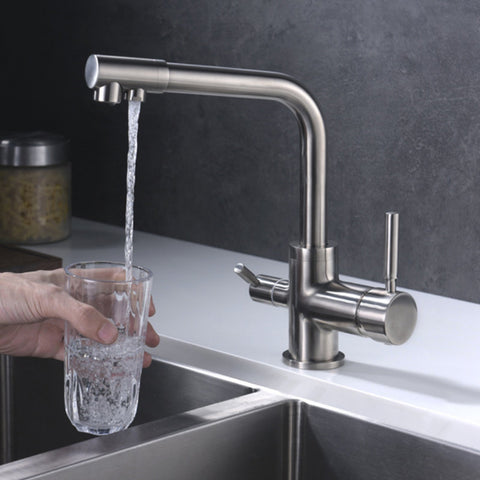Legionella in drinking water: real danger or scaremongering? How can you protect yourself in the kitchen and while showering?
Reports of Legionella contamination in drinking water are frequent. Despite this, many people still underestimate these tiny organisms and are unaware that they can be exposed to the risk of infection daily.
Whether Legionella bacteria in drinking water pose a real danger or whether it's all just exaggerated scaremongering, you can find out in this article.
Are Legionella bacteria really dangerous?
If you have a Legionella infection, there is a risk that you will develop Legionnaires' disease.
While the resulting Pontiac fever is not quite as severe, Legionnaires' disease can be fatal in extreme cases.
Legionnaires' disease is a severe form of pneumonia. Symptoms include chest and headaches, chills, high fever, and coughing. Confusion may also occur.
The illness lasts for four weeks and unfortunately about one in ten of those infected die from it.
Those who contract Pontiac fever usually recover within three to seven days. They feel similar to those with the flu. Flu-like symptoms include malaise, body aches and pains, fever, headache, chest pain, and a dry cough.
What makes Legionella bacteria dangerous is that even a small number of bacteria is enough to cause illness.
In over 90 percent of cases, the species Legionella pneumophila can be detected. More than 57 species of Legionella are known.
Who is particularly at risk?
- older people
- weakened people / people with a poor immune system
- chronically ill / pre-existing conditions
- Smokers
- Babies
If the number of germs is particularly high, even healthy and fit people can contract the dangerous disease Legionnaires' disease.
But how do the harmful Legionella bacteria even get into the human body?
An underestimated danger: Legionella bacteria while showering
There's nothing better than stepping into the shower after a long day at work and letting the water run down your back. The calming effect sets in quickly, and you leave the stress of everyday life behind. The increasing steam brings a feeling of relaxation and is reminiscent of a thermal spa or thermal bath.
What many people don't realize is that Legionella bacteria can be present in showerheads. While low concentrations are harmless, the situation changes when too many of these pathogens have accumulated or multiplied.
Then there is a risk that they can enter the lungs through inhalation of the water vapor. In severe cases, this can lead to Legionnaires' disease, which is a form of pneumonia.
Legionella in the kitchen
There is also a risk of dangerous germs in the water in the kitchen.
Drinking water containing Legionella bacteria is not dangerous if it enters the esophagus. However, if you choke on it and it accidentally enters the trachea, then even tap water can cause illness.
The same applies to consuming freshly washed and still wet fruit and vegetables.
A suitable water filter will solve the problem once and for all.
Up to 99.99 percent of germs and bacteria are removed.
Furthermore, you can drink the filtered water without hesitation, as it is free from potentially harmful antibiotic and pesticide residues.
If your apartment or house has old pipes, you can still drink the water safely thanks to a water filter. You'll never have to lug heavy crates again and you'll save yourself a trip to the beverage store.
Why a rapid Legionella test is not enough
Legionella rapid tests are available commercially for around 67 euros. These tests allow you to test water for disease-causing Legionella bacteria and receive the results within two days.
While such a test is ideally suited to checking the water for germs and bacteria, it only provides a snapshot in time.
For a reliable result, you should therefore conduct tests regularly. However, this requires testing several taps, as contamination can depend on various factors. Consequently, you will need multiple rapid tests, which can become very expensive in the long run.
It's cheaper and safer to prevent Legionella bacteria from multiplying and passing through the steel regulator in the first place. Special water filters offer a more economical long-term solution while providing you with clean water.
Preventing Legionella in bathrooms and kitchens - here's how
It is important that you use all water pipes in the house regularly. Legionella bacteria thrive in stagnant water and multiply rapidly as a result.
If you are away or haven't used the shower or bathtub for an extended period, you should drain the standing water from the pipes. It is recommended to drain at least ten liters carefully.
Make sure you do not inhale the steam under any circumstances and ideally open the window during this time. Afterwards, you can shower or bathe as usual.
The same applies to the kitchen tap. Let the water run for a while before drinking it or using it to wash fruits and vegetables. Never use stagnant water for this.
Remember to clean and descale the steel regulators of all taps from time to time to prevent Legionella bacteria from multiplying in them.
The safest way is probably to heat the water to over 55 degrees Celsius. Only at this temperature do the Legionella bacteria die and no longer pose a health risk. 60 degrees Celsius is even better.
However, this has the disadvantage that the water is much too hot for you, which could result in scalding.
Anyone who thinks that a hot shower is enough will be disappointed. Showering with 43-degree Celsius water does not protect against Legionella. Quite the opposite. They multiply readily at water temperatures between 23 and 45 degrees Celsius.
Before you lose all enjoyment of showering due to disgust and live in constant fear of infection, you should know that there are shower water filters that neutralize Legionella bacteria. A high-quality shower water filter traps Legionella, bacteria, parasites, and other microorganisms.
This means you are no longer exposed to any health risks while showering.
Safe tap filters ensure legionella-free water from the tap.
To avoid bacteria in drinking water, the right water filter in the kitchen can provide comprehensive protection against Legionella.
How do I find the right filter for my shower and faucets?
We at the water station in Berlin have a large assortment of water filters of various types.
In addition to our wide selection of shower filters, we offer various water filtration systems for the kitchen. Depending on the available space, these can be either countertop or under-counter water filters.
We encourage you to explore our services and contact us if you have any questions. Our expert team will address your concerns and do everything possible to meet your individual needs.
Conclusion: How can you prevent Legionella contamination at home?
Legionella bacteria are transmitted through aerosolized or atomized water. Consequently, you can become infected with Legionella in your home through the shower, faucets, or air conditioning system.
To avoid serious pneumonia, it is recommended to install water filters in the shower and on the taps in the bathroom and kitchen.
This protects you and your family from dangerous Legionella bacteria, allowing you to use kitchen water with peace of mind. Furthermore, you no longer need to worry about Legionella infection from hot steam while showering.
Update July 2022: The German manufacturer Carbonit has released a shower filter that protects against Legionella. Contact us for more information.




Comments (0)
There are no comments for this article. Be the first one to leave a message!